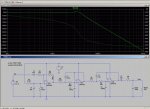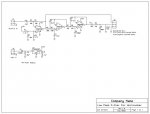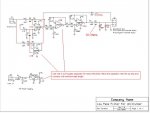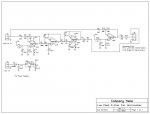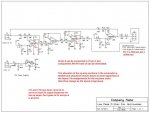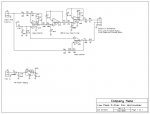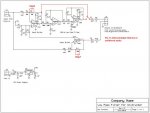Umm, a few points here:
Again, as I wrote before, I strongly suggest that you put at least a cap and resistor inline on the bypass line. As you have it now, that line will have DC on it from the DC bias used on the op-amps. Also, where you have it tapped, between R4 and R5 it may be isolated enough from the inputs of the active filter stages from the point of view of the sound card input but you may still have issues wherein the sound card input may affect the filter operation - it depends on the input of the particular sound card used. I would play it safe and provide at least minimum isolation using a series 2K to 10K resistor and non-polarized electrolytic cap of the same value as C2 and C7 (10uF). Personally, I feel that it would be best to simply add another buffer stage in the bypass line - why take any chances? - if you end up using dual op-amp IC's then you have a fourth op-amp available anyway so why not use it?! Just add the same buffer amp design that is used in the main circuit (U1A) in the bypass line with ac coupling (DC blocking caps - same 10uF caps used on the main circuit). Just repeat the buffer stage including DC blocking caps both before and after it in the bypass line and you are good to go. Something I did forget to mention in my previous post though is that if you do this (use a separate buffer stage in the bypass line), then move the tap back to the point at the input (before C2) kind of like your first schematic; otherwise, if you don't use the fourth op-amp, then keep the tap where it is and at least add a series DC blocking cap of 10uF (non-polarized electrolytic, preferably) and a series resistor of 2K to 10K ohms (it can be higher and is not terribly critical but don't go lower than 2K, I think). But, as I said - if your using two dual op-amp IC's why not put the fourth op-amp to good use!
And since we're on the subject of dual op-amp IC's - in my experience, when creating a schematic depicting the use of multiple devices on multi-device IC's it is good practice to number the devices as UX-A, UX-B, etc. so as to show that you are using device 1 (say "U1-A") from the same IC as device 2 (say "U1-B"). In your schematic's case you have two U1's which would be better named as U1-A and U1-B (to indicate the two devices from the same IC). So, U2 would be U2-A and U2-B would be either unused or used as I suggested in the bypass line.
Finally, as I also stated in my previous post, those two components at the end of pro92b's schematic represent the simulated load of the sound card input used purely for his computer simulation as depicted in his post (that is why they are labeled "CLoad" and "RLoad" in his simulation schematic rather than using numbers like the other components). They are NOT part of the main circuit so should NOT be included in the schematic for the circuit as you have done; just delete C8 and R10.
I'd draw up a schematic for you but my only real schematic capture software from the old days is really old and I am not sure where the CD is hiding! If you have questions, though, feel free to PM me and we can sort it all out.
-Mike


